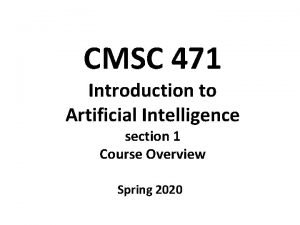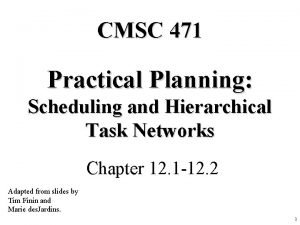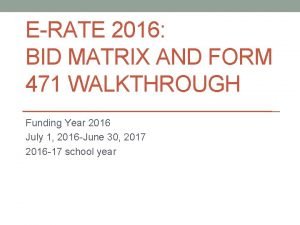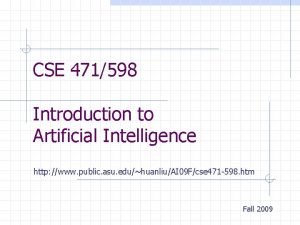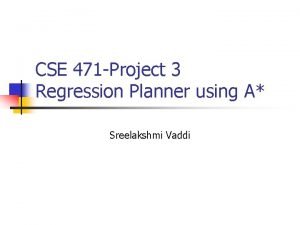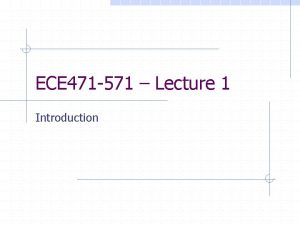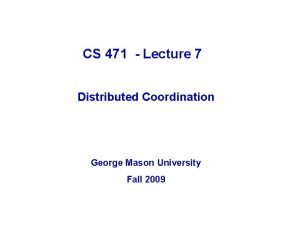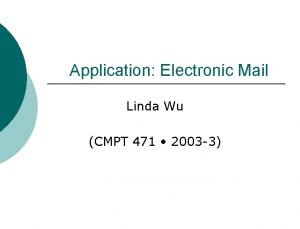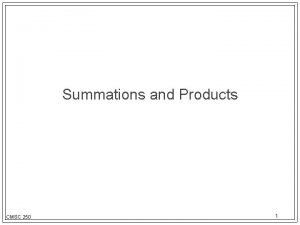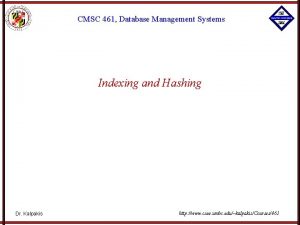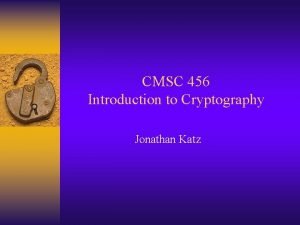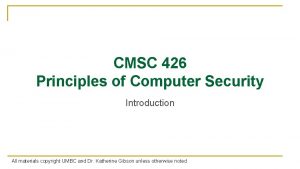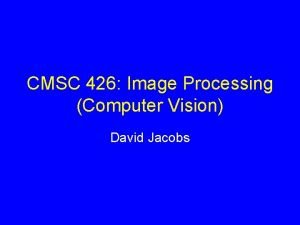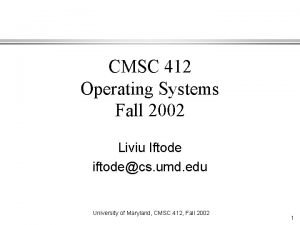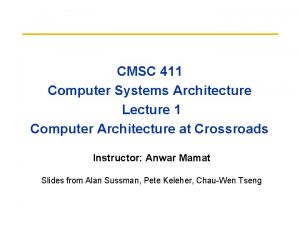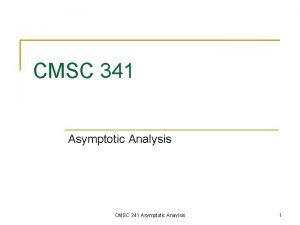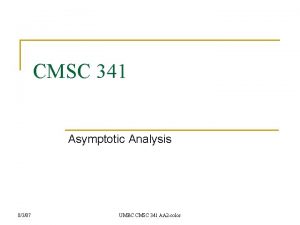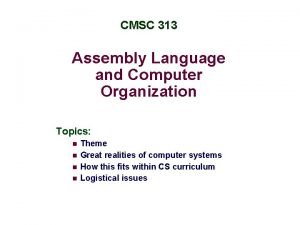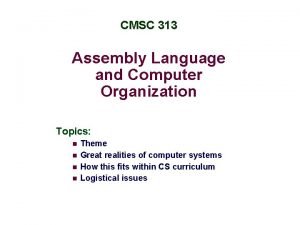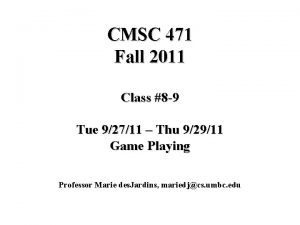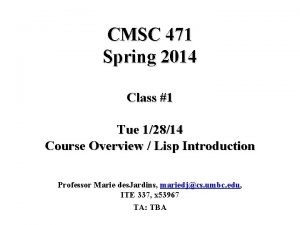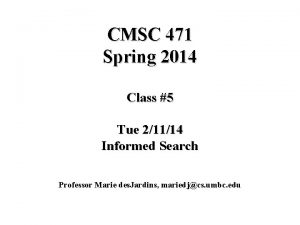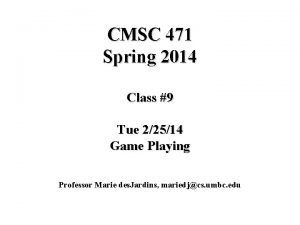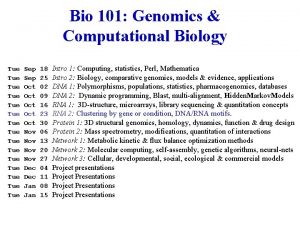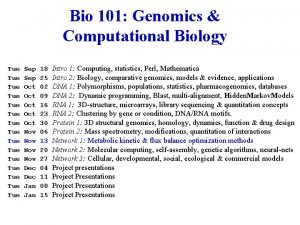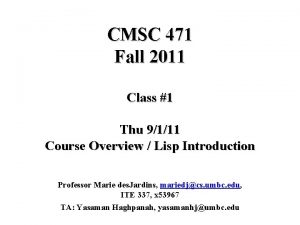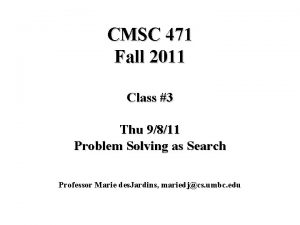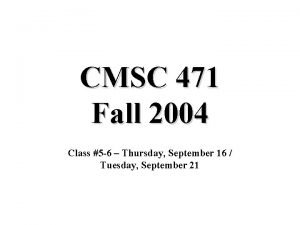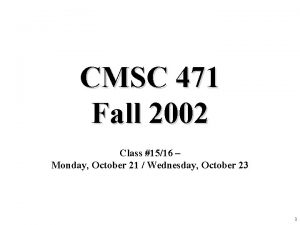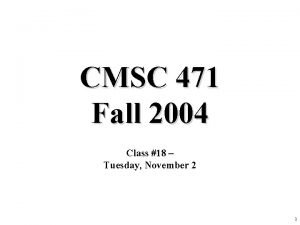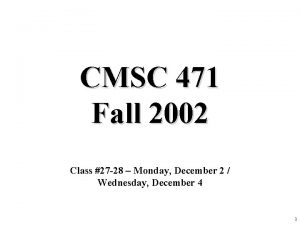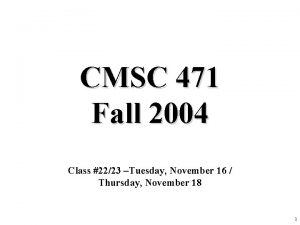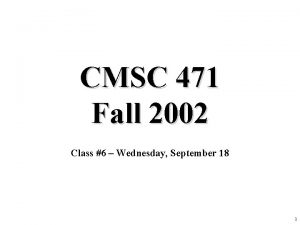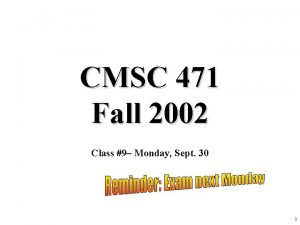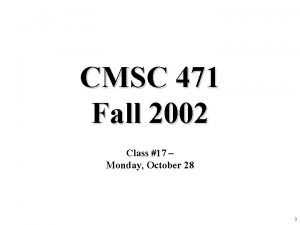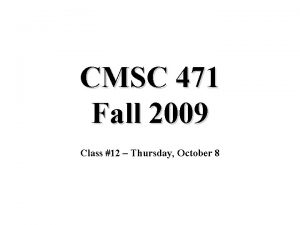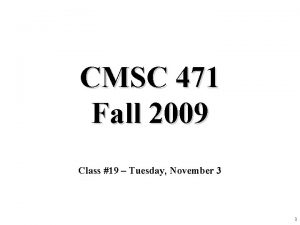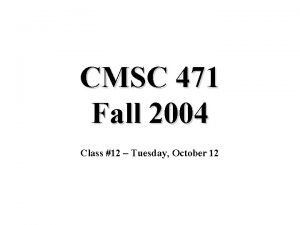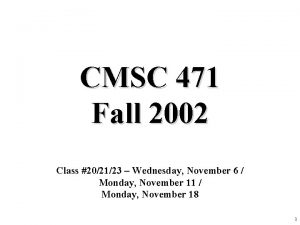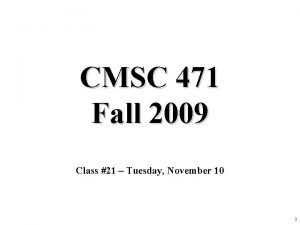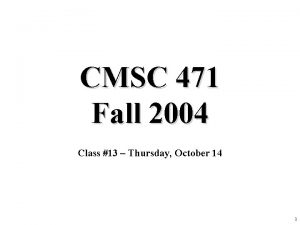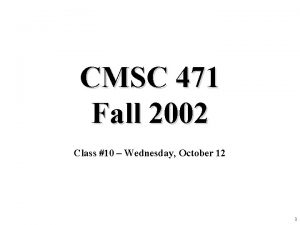CMSC 471 Fall 2011 Class 4 Tue 91311


























- Slides: 26

CMSC 471 Fall 2011 Class #4 Tue 9/13/11 Uninformed Search Professor Marie des. Jardins, mariedj@cs. umbc. edu

Today’s Class • Specific algorithms – – Breadth-first search Depth-first search Uniform cost search Depth-first iterative deepening • Example problems revisited

Uninformed Search Chapter 3 Some material adopted from notes by Charles R. Dyer, University of Wisconsin-Madison

Key Procedures to be Defined • EXPAND – Generate all successor nodes of a given node • GOAL-TEST – Test if state satisfies all goal conditions • QUEUEING-FUNCTION – Used to maintain a ranked list of nodes that are candidates for expansion

Bookkeeping • Typical node data structure includes: – – State at this node Parent node Operator applied to get to this node Depth of this node (number of operator applications since initial state) – Cost of the path (sum of each operator application so far)

Some Issues • Search process constructs a search tree, where – root is the initial state and – leaf nodes are nodes • not yet expanded (i. e. , they are in the list “nodes”) or • having no successors (i. e. , they’re “deadends” because no operators were applicable and yet they are not goals) • Search tree may be infinite because of loops even if state space is small • Return a path or a node depending on problem. – E. g. , in cryptarithmetic return a node; in 8 -puzzle return a path • Changing definition of the QUEUEING-FUNCTION leads to different search strategies

Evaluating Search Strategies • Completeness – Guarantees finding a solution whenever one exists • Time complexity – How long (worst or average case) does it take to find a solution? Usually measured in terms of the number of nodes expanded • Space complexity – How much space is used by the algorithm? Usually measured in terms of the maximum size of the “nodes” list during the search • Optimality/Admissibility – If a solution is found, is it guaranteed to be an optimal one? That is, is it the one with minimum cost?

Uninformed vs. Informed Search • Uninformed search strategies – Also known as “blind search, ” uninformed search strategies use no information about the likely “direction” of the goal node(s) – Uninformed search methods: Breadth-first, depthlimited, uniform-cost, depth-first iterative deepening, bidirectional • Informed search strategies (next class. . . ) – Also known as “heuristic search, ” informed search strategies use information about the domain to (try to) (usually) head in the general direction of the goal node(s) – Informed search methods: Hill climbing, best-first, greedy search, beam search, A, A*

Example for Illustrating Search Strategies S 3 3 D A B 15 7 E 8 1 C 20 G 5

Uninformed Search Methods

Breadth-First • Enqueue nodes on nodes in FIFO (first-in, first-out) order. • Complete • Optimal (i. e. , admissible) if all operators have the same cost. Otherwise, not optimal but finds solution with shortest path length. • Exponential time and space complexity, O(bd), where d is the depth of the solution and b is the branching factor (i. e. , number of children) at each node • Will take a long time to find solutions with a large number of steps because must look at all shorter length possibilities first – A complete search tree of depth d where each non-leaf node has b children, has a total of 1 + b 2 +. . . + bd = (b(d+1) - 1)/(b-1) nodes – For a complete search tree of depth 12, where every node at depths 0, . . . , 11 has 10 children and every node at depth 12 has 0 children, there are 1 + 1000 +. . . + 1012 = (1013 - 1)/9 = O(1012) nodes in the complete search tree. If BFS expands 1000 nodes/sec and each node uses 100 bytes of storage, then BFS will take 35 years to run in the worst case, and it will use 111 terabytes of memory!

Depth-First (DFS) • Enqueue nodes on nodes in LIFO (last-in, first-out) order. That is, nodes used as a stack data structure to order nodes. • May not terminate without a “depth bound, ” i. e. , cutting off search below a fixed depth D ( “depth-limited search”) • Not complete (with or without cycle detection, and with or without a cutoff depth) • Exponential time, O(bd), but only linear space, O(bd) • Can find long solutions quickly if lucky (and short solutions slowly if unlucky!) • When search hits a deadend, can only back up one level at a time even if the “problem” occurs because of a bad operator choice near the top of the tree. Hence, only does “chronological backtracking”

Uniform-Cost (UCS) • Enqueue nodes by path cost. That is, let g(n) = cost of the path from the start node to the current node n. Sort nodes by increasing value of g. – Identical to breadth-first search if all operators have equal cost • Called “Dijkstra’s Algorithm” in the algorithms literature and similar to “Branch and Bound Algorithm” in operations research literature • Complete (*) • Optimal/Admissible (*) • Admissibility depends on the goal test being applied when a node is removed from the nodes list, not when its parent node is expanded and the node is first generated • Exponential time and space complexity, O(bd)

Depth-First Iterative Deepening (DFID) • First do DFS to depth 0 (i. e. , treat start node as having no successors), then, if no solution found, do DFS to depth 1, etc. until solution found do DFS with depth cutoff c c = c+1 • Complete • Optimal/Admissible if all operators have the same cost. Otherwise, not optimal but guarantees finding solution of shortest length (like BFS). • Time complexity is a little worse than BFS or DFS because nodes near the top of the search tree are generated multiple times, but because almost all of the nodes are near the bottom of a tree, the worst case time complexity is still exponential, O(bd)

Depth-First Iterative Deepening • If branching factor is b and solution is at depth d, then nodes at depth d are generated once, nodes at depth d-1 are generated twice, etc. – Hence bd + 2 b(d-1) +. . . + db <= bd / (1 - 1/b)2 = O(bd). – If b=4, then worst case is 1. 78 * 4 d, i. e. , 78% more nodes searched than exist at depth d (in the worst case). • Linear space complexity, O(bd), like DFS • Has advantage of BFS (i. e. , completeness) and also advantages of DFS (i. e. , limited space and finds longer paths more quickly) • Generally preferred for large state spaces where solution depth is unknown

Uninformed Search Results

Depth-First Search Expanded node S 0 A 3 D 6 E 10 G 18 Nodes list { S 0 } { A 3 B 1 C 8 } { D 6 E 10 G 18 B 1 C 8 } { B 1 C 8 } Solution path found is S A G, cost 18 Number of nodes expanded (including goal node) = 5

Breadth-First Search Expanded node Nodes list { S 0 } S 0 { A 3 B 1 C 8 } A 3 { B 1 C 8 D 6 E 10 G 18 } B 1 { C 8 D 6 E 10 G 18 G 21 } C 8 { D 6 E 10 G 18 G 21 G 13 } D 6 { E 10 G 18 G 21 G 13 } E 10 { G 18 G 21 G 13 } G 18 { G 21 G 13 } Solution path found is S A G , cost 18 Number of nodes expanded (including goal node) = 7

Uniform-Cost Search Expanded node Nodes list { S 0 } S 0 { B 1 A 3 C 8 } B 1 { A 3 C 8 G 21 } A 3 { D 6 C 8 E 10 G 18 G 21 } D 6 { C 8 E 10 G 18 G 1 } C 8 { E 10 G 13 G 18 G 21 } E 10 { G 13 G 18 G 21 } G 13 { G 18 G 21 } Solution path found is S B G, cost 13 Number of nodes expanded (including goal node) = 7

How they Perform • Depth-First Search: – Expanded nodes: S A D E G – Solution found: S A G (cost 18) • Breadth-First Search: – Expanded nodes: S A B C D E G – Solution found: S A G (cost 18) • Uniform-Cost Search: – Expanded nodes: S A D B C E G – Solution found: S B G (cost 13) This is the only uninformed search that worries about costs. • Iterative-Deepening Search: – nodes expanded: S S A B C S A D E G – Solution found: S A G (cost 18)

Bi-directional Search • Alternate searching from the start state toward the goal and from the goal state toward the start. • Stop when the frontiers intersect. • Works well only when there are unique start and goal states. • Requires the ability to generate “predecessor” states. • Can (sometimes) lead to finding a solution more quickly.

Comparing Search Strategies

Avoiding Repeated States • In increasing order of effectiveness in reducing size of state space and with increasing computational costs: 1. Do not return to the state you just came from. 2. Do not create paths with cycles in them. 3. Do not generate any state that was ever created before. • Net effect depends on frequency of “loops” in state space.

A State Space that Generates an Exponentially Growing Search Space

Holy Grail Search Expanded node S 0 C 8 G 13 Nodes list { S 0 } {C 8 A 3 B 1 } { G 13 A 3 B 1 } { A 3 B 1 } Solution path found is S C G, cost 13 (optimal) Number of nodes expanded (including goal node) = 3 (as few as possible!) If only we knew where we were headed…

8 -Puzzle Revisited Depth-first search? Breadth-first search? Uniform-cost? Iterative deepening?
